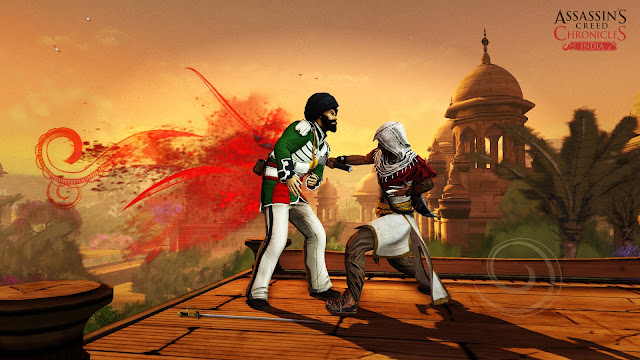I’m a fan of the Assassin’s Creed franchise, which I see as the more intelligent and insightful of the major blockbuster franchises. That being said, I am a much bigger fan of the games in the series where Ubisoft takes a creative risk and does something a little daring to go with the sweeping cross-era epic narrative of Templar-vs-Assassin.
Related reading: For a review of the first chapter of this trilogy, Assassin’s Creed Liberation: China, click on over here.
So when Ubisoft decided to cast a black woman as an assassin for its Assassin’s Creed Liberation, I was much more interested in that game, technical warts and budget limitations aside, than I was of the much more highly produced PlayStation 3/ Xbox 360 Assassin’s Creed 3 and 4. And when Assassin’s Creed Chronicles: China landed, starring a Chinese female assassin, I was far more involved in it than I was playing the safe male hero in the glistening, boring city of Paris in Assassin’s Creed: Unity.
Now the second of the Assassin’s Creed: Chronicles games has landed and this time the hero (Arbaaz Mir) is from a Muslim family, and he’s dashing around an 1841 India that has not yet become completely dominated by the English. Let’s let that set in for a second. While it’s not even close to heavy handed about this (you wouldn’t even necessarily realise the Mir’s religious background if you didn’t delve into the hidden documents you pick up along the way), I think we can all agree that this is an incredibly daring narrative to be applying to one of the most mainstream franchises out there.
And it does so in such breathtaking style. Colonial India is a gorgeously vibrant setting for any game; one that is far too underutilised in games. I suspect that is the case because it shares aesthetic similarities to the Middle Eastern settings that are such a touch of death for modern entertainment that when Hollywood produced a Prince of Persia film it cast an American to put on the thickest British accent he could possibly manage so that every single person in the audience would be reminded in every single scene that he wasn’t a real Persian. From the bright colours of the markets, to the unique architecture of a classical Indian city, Chronicles: India is a game that absolutely revels in its exoticness, and as a result every new environment is one to anticipate, so dripping in atmosphere as it is.
As with its China-set predecessor, however, I can’t help but wonder about how much better it would be still if Ubisoft allowed the third party developer behind this series (Climax Studios) access to the Ubiart framework to draw the backgrounds in even greater vibrancy. There is no better 2D engine going at the moment than the one that powers the modern Rayman games, Child of Light and Valiant Hearts, and I have for the longest time felt that an Assassin’s Creed game would be a perfect fit for continued use of it. We’ll get to the gameplay in a moment, as this series does indeed prove that Assassin’s Creed works as a 2D stealth platformer, but as good as the art in the Chronicles games are, it could still be better were they to utilise Ubiart.
But that really is the faintest of criticisms that I could possibly level at the game because, at risk of overusing the word, Chronicles: India really is gorgeous. The brief cut-scenes also help to set the scene, with the developers demonstrating a very deep understanding of the aesthetic of the time and region of the world. Exotic, beautiful women, gaudy, colourful costuming and intricate patterns all combine to create a world that simply demands to be explored.
As with all Assassin’s Creed games, the setting and narrative is historically authentic without being accurate. The backdrop and political and social tensions of the time are all very much in line with what really happened, and the game has a habit of name-dropping important people and artifacts from the real history to help build its historic credibility, but it is also very much a work of fiction and should be taken as such. Still, as I was playing I did find myself reaching for Wikipedia to expand on various tidbits of information I came across (for example, I had no idea what the Koh-i-Noor diamond was before I started playing this game), and as with any good historical game I actually came away from this one with a better understanding of the history of India than I did going in, and I can respect any game that actually teaches me as I play.
It should be mentioned, however, that the Chronicles games do not have the budget that the “real” Assassin’s Creed games do, and this is reflected in the storytelling, too. Where those games are sprawling historical epics, this one is more of a novella, with short cut scenes, and far fewer pages of informative collectables to help fill out the backstory. While it’s a complete novella and tells the story it wants to, it’s a little bittersweet completing it, as it’s hard not to walk away wanting more depth and content to work through.
However, the game itself is long enough for the price, thanks to the amount of time you will be spending doing, well, adventuring, rather than watching passive cut scenes. If you were to break Chronicles: India down, it works like a series of puzzles. Mir will enter an area, and need to navigate his way past a series of guards, traps, and environmental puzzles, to reach the other side. It’s not easy, either. Mir is not a particularly effective combatant, and can be easily overwhelmed if even a couple of guards come at him. He can sneak up on them to take them down by stealth, but each guard has a sight range, and they often cross with one another, so timing any attempt to stealthily take down an enemy requires precision and finesse.
The real sign of skill, however, is in getting through an area without being spotted or needing to take down anyone. You’ll be graded based on these factors, and the only way to get a perfect score is to be a genuine shadow. It doesn’t take long for the “puzzles” to become exceedingly difficult, and rely on players being able to utilise a combination of timing, quick thinking, as well as the assassin’s bag of dirty tricks such as smoke bombs and noise arrows, to have any hope of getting through unseen.
It’s never frustrating, however, as the checkpoints come frequently, and typically after a couple of failures the correct path through a level starts to make itself clear. The only disappointing issue with this all is that the placement and movement of enemies begins to feel arbitrary after a while. They’re placed – and move – in optimal patterns to make life difficult, but it’s an artificial effect that starts to wear the luster of authenticity after a while.
Still, it’s exciting to finally succeed in sneaking through a building crawling with enemies without being seen. The catlike grace with which Mir walks remains mesmerising from start to finish, and when there is combat, it’s fast, fluid, and flashy. Indeed, it’s almost a pity that Mir is such a glass cannon, because the combat system makes incredible use of blocks, counters, rolls and feints, but is never really left to shine, because you’ll almost never want to actually get in a scrap. But then if the developers put a greater focus on the combat it would have meant the game isn’t as satisfying for people who achieve a pacifist path through it, so on balance I think this is a fair trade-off.
I really enjoyed Assassin’s Creed Chronicles: China, but I think this one takes a giant leap forward. While the core mechanics remain functionally the same, that (even more) exotic setting and (lesser known) time period, brilliant environment design and brief, but effective, narrative all combine to make something that offers just that little bit more. I’m greatly looking forward to the concluding chapter in this trilogy, as I know next to nothing about the period of Russian history that it’s set, so I’ll be going in fully prepared for a schooling.
Oh, and as an aside; colonial India might not be the Middle East, but as I noted in the review, there are some architectural and aesthetic similarities. Enough to make me yearn for a new Prince of Persia all over again. C’mon Ubisoft, respect your fans enough to know that they can play a game set in the Middle East without winding up offended by that.
– Matt S.
Editor-in-Chief











